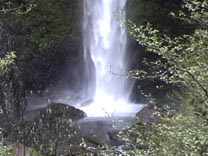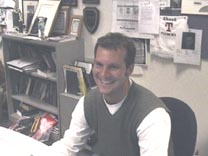| Our first look at Bonneville Dam. (Photo: Jimmy Zamora) | |
| Students standing next to Bonneville Dam Turbine. (Photo: Marlon Dick) | |
 | VIDEO: Students and Fish. |
INTRODUCTION
On April 17, students from Burns High School helping with the Harney County website were given the opportunity to examine the landscape and cattle grazing along the Columbia River Gorge and Portland area to see how it differs from Harney County. From the 17 thru the 21 of April we toured the Bonneville Dam and Hatchery, Columbia River Gorge, Laourell Falls, Oregon Beef Council, Jefferson High School, Oregonian, Senator Gordon Smith’s office, Portland, Soup Creek and Soap Creek Valley at Oregon State University. Jamie Moline, Christa Cooper, Mandy Cronin, Rebecca Danner, Eric Garner, Marlon Dick, Tarah McCanna, and Carol Robinson each wrote a brief summery of at least one of the places we visited.
BONNEVILLE DAM AND HATCHERY
The first stop was the Bonneville dam. It was a very educational place to visit. We learned about chinook, salmon, and steelhead and how they travel up the fish ladders. We also learned about their population and how the dams affected their migration. Seeing the sturgeon ponds was also exciting.
| Our first look at Bonneville Dam. (Photo: Jimmy Zamora) | |
| Students standing next to Bonneville Dam Turbine. (Photo: Marlon Dick) | |
 | VIDEO: Students and Fish. |
THE COLUMBIA RIVER GORGE
| Becka, Mandy,and Tarah walking by a water stream. (Photo: Jimmy Zamora) |
| Gorge and Crown Point. (Photo: Eric Garner) |
The gorge was created by Bretz floods[Allen and others 1986]. The crests of the floods dropped in elevation from 1000 feet at the Dalles to 700 feet at Crown Point.
Transportation of cattle through the gorge would have been very difficult! Cattle could fall off of the cliffs, or be swept away by the swift rivers. Cattle were trailed over the Barlow Road to the stockyards to avoid the gorge. Later on, the railroad was built to help transport cattle and other goods to Portland.
| Lunch (left to right): Bob, Carol, Christa, Eric, Jamie, Becka, Mandy, and Tarah. (Photo: Jimmy Zamora) | |
| Eric, Marlon, Jamie, and Christa on top of Laourell Falls. (Photo: Jimmy Zamora) | |
 | VIDEO: Waterfalls |
Dianne Johnston the executive director of the Oregon Beef Council talked to us as well as Dana Peterson, who is the Promotion director. We learned that chicken is beef's main competitor, followed by pork, turkey, and fish. The beef council is trying to promote beef as a main holiday meal. One of the their main promotions is the Beef Blitz. Members of the Oregon Cattlewomen pair up with volunteers from high schools and Oregon State University. They then cook a beef recipe for students in grade schools, junior high, or high schools. You can get to their website at www.orbeef.org. They give a lot of information and even beef recipes. It was a lot of fun.
JEFFERSON HIGH SCHOOL
On the early morning of April 19, 2002 we headed out to Jefferson High School in Portland, Oregon to give a presentation to Mr. Mike Rooney’s physical science class about grazing and every day life in Harney County. We opened by talking a little about the history and ways of life and how it differs with 350 miles between us. The students at Jefferson High were very entertained with the idea of early mornings, branding cattle, and slaughtering. In turn we also learned a lot about what they do everyday and how their lifestyle is. After the presentation Brian and Lisa (two of the students at Jefferson High) gave us a tour of the Jefferson High TV studio and other facilities in the school.
The Oregonian is the largest daily news paper and also the oldest in the Pacific Northwest. The tour of the Oregonian started off with a briefing on public outreach presented by Stephanie Oliver (who handles public affairs) followed by a quick look at what goes on in the news rooms at the Oregonian headquarters. We also learned what it takes to present a news paper to the public each and every day. Stephanie, also introduced us to Jason Quick who is one of several sports writers that covers the Trail Blazers games. He said a quick hello, and gave us his insight on the upcoming Portland / L.A game .
| Stephanie Oliver giving us a tour of the Oregonian Headquarters. (Photo: Jimmy Zamora) | |
 | VIDEO: Jason Quick |
PORTLAND
| Harney County Students in Senator Smith’s office. (Photo: Nana Lapham) | |
| View of Willamette river as seen from Senator Smith’s office. (Photo: Jimmy Zamora) |
On April 19, we had dinner at Colette’s in Salem with Katie Cate, a member of the Oregon Cattlemen’s Association. She gave us a brief presentation on Oregon Cattle Men and Women, which represents the Oregon Cattle industry. Katie also gave us a magazine (reference here) and a handout.
On Saturday morning we went to the OSU Valey Library to make this virtual tour of our field trip. Students worked with Bob and Albert on the website. We had selected pictures to put on the website. While we were selecting the pictures we had to make a caption to go with that picture. Text descriptions were written about certain sites that we had attended on our field trip. Two of us had taken pictures of the campus while we were on a guided tour. We had taken pictures of several sites that we had seen on the tour. Few pictures of what OSU football team had been doing that day while we were taking our tour. We ate lunch at the MU at Oregon State. The day concluded with a nice baseball game at OSU.
SOAP CREEK VALLEY RANCH
Students were given a great discussion on what goes on at the ranch and how some college students come out and help. They try to find the difference between the normal branding and the freeze branding method. The normal method uses a hot iron and the freeze banding uses dry ice to put the brand on the animal. The Soap Creek Ranch has three hundred pairs of cattle.
| Students learning about what happens at Soap Creek Valley Ranch (Photo: Jimmy Zamora) | |
| Black angus cattle taking it easy on Soap Creek Valley Ranch (Photo: Jimmy Zamora) |
SULFUR SPRINGS
On Saturday afternoon we visited Sulfur Springs and learned a little bit about the history. It is rumored that if you drink the water from the spring you will live a longer life, so most of us tried it. While we were there, Eric and Jamie went for a quick “dip” in the creek nearby.
TAMPICO
Saturday morning we headed out to the Soap Creek Valley Ranch but before we got to the Ranch we stopped at what...
OVERALL REVIEW OF THE FIELD TRIP
Overall the trip was great, we had SO much fun! Not only learning but also interacting with a variety of people. It was such a treat to be able to come to northwestern Oregon to learn a little bit about agriculture here and learning to put a web site together. It’s a great experience going and learning about things and seeing how different the landscape and terrain in agriculture differ from home. We have learned a lot that we can use later on in life. From things such as difference between rural and urban areas to how gross oysters are.